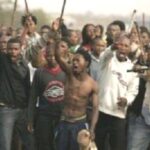Importance Of ‘Agberen’ In Okpe Traditional Funeral In Urhobo Nation
LAGOS DECEMBER 9TH (NEWSRANGERS)-Belief is a major factor that defined a man or group of people. Belief forms a tradition which is the rules that governs a people, belief also form culture which is the life style of a people. The segmentation of nations and people of the world is endangered by their belief, in Africa we have our belief; they are what makes us Africans, Nigeria has her belief which makes us Nigerians, in Okpe Kingdom they have their belief which equally makes the Okpe people. Tradition and culture are product of human belief and these defined the people. The Okpe people migrated from Bini (Benin) according to scholars, the Okpe kingdom is establish as early as the 17th century, the traditional ruler is known and address as the Orodje of Okpe kingdom.
The migration from Bini by Prince Igboze to their present location was done in several stages, Oreokpe is their royal home and that is where the Orojie resides, other towns and villages are: Sapele, Aghalokpe Ibadan-Elume, Adeje mereje, okwetolo etc. These people are known for their rich tradition and culture, one of which is the traditional carrying of an “Agberen” a box like structure prepared for the spirit of the deceased. This traditional funeral rites is performed for those from the royal lineage, they enjoy this honour at death, and therefore not every family performs it. This ceremony takes place immediately after the interment of the corpse.
The “Agberen” can be described as a special casket shaped bamboo box which is covered with the deceased special clothes (wrappers) and velvet materials which is placed at the top of caricature casket; three special head-ties are specially wrapped and arranged in three parts and placed on top of the “Agberen”. Two chairs are placed for the eldest son and daughter of the deceased person to sit throughout the days of the ceremony.
The materials used in building the “Agberen” are bamboo sticks which are carefully and craftily joined together to form the desired shape of the caricature casket. It is then placed under a canopy like structure with four post holding it at each angle with roof in form of a house. It is lined up with mats (Abiba) in Okpe language. The back and the two side of the structure are specially built with tiny bamboo sticks and covered with assorted lined and sparking velvet materials giving the temporary structure a special and colorful look. The front is the in-let in which the deceased family can go in and out, the floor is equally covered with mats and special clothes.
The “Agberen” ritual performance as described above is done by the people from a royal lineage. A man’s “Agberen” exercise takes seven days and that of a woman five days according to the Tradition. The hair, the toe nails and finger nails of the deceased are timed and put in the casket structure, upon completion of the casket like structure, the deceased spirit is invoked into the casket like structure by some special people in the family mostly the elderly. At the front, three tubers of yam, a native earthen pot, local gin (ogogoro), kolanuts, calabash rattle and the picture of the deceased are placed.
On the First day of the ritual performance, native cow is slaughtered and the head is cooked with yam and plantain in a pot and kept in front of the “Ageren” to be eaten by the eldest son and daughter, subsequently native goat are slaughtered, traditional dancers are engaged, their local dishes are prepared as the elders sits with the children in front of the “Agberen” as they pray for the children with (ogogoro) local gin and pouring of libation, this is done for the number of days the traditional rite will last.
On the last day strong men are prepared to carry the caricature casket, this could be done before 12 noon or about 4pm. It is believed that the spirit of the deceased is inside the caricature casket and will control the movement of the carriers to wherever the spirit decides to go. For instance, they could lead them (group) to the residence of his/her loved ones.
It is believed, those that hated the deceased while alive would be evaded by the spirit. During the procession, paternal and maternal family members, friends, well wishes holds a woven jute bag “Ebo” where raw groundnuts, sweets, biscuits, coins, cowries matches etc. are kept, while they sing and dance to the songs with instruments like iron gong (Agogo), native drums and bamboo sticks, the contained in the bags are being thrown out as they items sing and dance. Some of the songs they chant and dance to; “Emo regbere we ni vwe Emo ri baba” Children of the poor don’t look at us, we are great father, that is Children from the royal family.
“Omiovwo vwe ranyo (2times) / “Omiovwo vwe ran yo inene”/ “Omiovwo vme ran ran eh ehi”/ Someone who has children is sweet (2times)
In the mother’s side, it is sweet, from the father’s side is sweet. Someone who has children is sweet eh eh “Iso gele gele, Iso (2times)
“Gele gele, Iso” The person in question is a famous person rich, reputable raise him/her higher because he/she deserve it. One of the significance is that the “Agberen” is used as a spiritual process of sending the deceased to join their ancestors.
Also the carrying of the Agberen” is seen as a pride to those from the royal background; it is believed that the deceased person will reincarnate from the same lineage. These traditional funeral rites have a lot of spiritual backing and power, it is not in any form a kind of social exercise, whoever falls in the process of dancing while the procession is on May likely die if such person is possessed. Those that have not performed this rite for their parents can’t participate or else they risk the danger of untimely death.
Heritage is a people’s pride and a people’s identity, without heritage a group of people does not only stand the risk of losing identity by also history. Archeological studies have shown that heritage is a major factor that gives a group of people right of settlement in a particular geographical location. It became evidence therefore that the loss of heritage is the loss of identity, pride, history and right of settlement.
‘Agberen’ is a royal funeral rite of one of such heritage that most not be lost because it proves the identity of Okpe people. This is an inheritance handed down by ancestral fathers of many generations, it will be disservice to humanity if at any point we trade the significance, lessons of our heritage. It will be unspeakable, unforgivable act to leave our children unborn with a sense of no direction as to their origin.
Appreciating the contributions of Christianity, western education and civilization that came, these no doubt have contributed positively to our lifestyle. Yet tradition and culture as a way of life have significant impacts that cannot be jettisoned.
To this effect every community or group of people should uphold, flower and propagate their heritage, traditional rites and culture so as to save their identity, pride, history and right of settlement in a given area.
Amaechi is Assistant Chief Curator, National Museum, Lagos
NewTelegraph
For advert placement, events coverage, media placement, public relation consultancy and further inquiries please WhatsApp 2348023773039 or email: labakevwe@yahoo.com





















